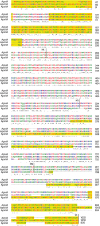1. Dayao DA, Gibson JS, Blackall PJ, Turni C. Antimicrobial resistance in bacteria associated with porcine respiratory disease in Australia. Vet Microbiol. 2014; 171:232–235.


2. Opriessnig T, Giménez-Lirola LG, Halbur PG. Polymicrobial respiratory disease in pigs. Anim Health Res Rev. 2011; 12:133–148.


3. Shin MK, Kang ML, Cha SB, Lee WJ, Sung JH, Yoo HS. An immunosorbent assay based on the recombinant ApxIa, ApxIIa, and ApxIIIa toxins of
Actinobacillus pleuropneumoniae and its application to field sera. J Vet Diagn Invest. 2011; 23:736–742.


4. Bossé JT, Janson H, Sheehan BJ, Beddek AJ, Rycroft AN, Kroll JS, Langford PR.
Actinobacillus pleuropneumoniae: pathobiology and pathogenesis of infection. Microbes Infect. 2002; 4:225–235.


5. Dubreuil JD, Jacques M, Mittal KR, Gottschalk M.
Actinobacillus pleuropneumoniae surface polysaccharides: their role in diagnosis and immunogenicity. Anim Health Res Rev. 2000; 1:73–93.


6. Xu Z, Chen X, Li L, Li T, Wang S, Chen H, Zhou R. Comparative genomic characterization of
Actinobacillus pleuropneumoniae. J Bacteriol. 2010; 192:5625–5636.



7. Dreyfus A, Schaller A, Nivollet S, Segers RP, Kobisch M, Mieli L, Soerensen V, Hüssy D, Miserez R, Zimmermann W, Inderbitzin F, Frey J. Use of recombinant ApxIV in serodiagnosis of
Actinobacillus pleuropneumoniae infections, development and prevalidation of the ApxIV ELISA. Vet Microbiol. 2004; 99:227–238.


8. Boekema BK, Kamp EM, Smits MA, Smith HE, Stockhofe-Zurwieden N. Both ApxI and ApxII of
Actinobacillus pleuropneumoniae serotype 1 are necessary for full virulence. Vet Microbiol. 2004; 100:17–23.


9. Inzana TJ, Todd J, Ma JN, Veit H. Characterization of a non-hemolytic mutant of
Actinobacillus pleuropneumoniae serotype 5: role of the 110 kilodalton hemolysin in virulence and immunoprotection. Microb Pathog. 1991; 10:281–296.


10. Ramjeet M, Deslandes V, Gouré J, Jacques M.
Actinobacillus pleuropneumoniae vaccines: from bacterins to new insights into vaccination strategies. Anim Health Res Rev. 2008; 9:25–45.


11. Schaller A, Kuhn R, Kuhnert P, Nicolet J, Anderson TJ, MacInnes JI, Segers RP, Frey J. Characterization of apxIVA, a new RTX determinant of Actinobacillus pleuropneumoniae. Microbiology. 1999; 145:2105–2116.


12. Shin SJ, Cho YW, Yoo HS. Cloning, sequencing and expression of apxIA, IIA, IIIA of Actinobacillus pleuropneumoniae isolated in Korea. Korean J Vet Res. 2003; 43:247–253.
13. Shin MK, Cha SB, Lee WJ, Yoo HS. Predicting genetic traits and epitope analysis of apxIVA in
Actinobacillus pleuropneumoniae
. J Microbiol. 2011; 49:462–468.


14. Oishi E, Kitajima T, Nakamura H, Matsuda C, Amimoto K, Yasuhara H. A field trial of oil adjuvanten trivalent
Actinobacillus pleuropneumoniae vaccine. J Vet Med Sci. 1997; 59:421–423.


15. Sjölund M, Wallgren P. Field experience with two different vaccination strategies aiming to control infections with
Actinobacillus pleuropneumoniae in a fattening pig herd. Acta Vet Scand. 2010; 52:23.



16. Xu K, Zhao Q, Wen X, Wu R, Wen Y, Huang X, Huang Y, Yan Q, Han X, Ma X, Chang YF, Cao S. A trivalent Apx-fusion protein delivered by E. coli outer membrane vesicles induce protection against Actinobacillus pleuropneumoniae of serotype 1 and 7 challenge in a murine model. PLoS One. 2018; 13:e0191286.
17. Lu YC, Li MC, Chen YM, Chu CY, Lin SF, Yang WJ. DNA vaccine encoding type IV pilin of
Actinobacillus pleuropneumoniae induces strong immune response but confers limited protective efficacy against serotype 2 challenge. Vaccine. 2011; 29:7740–7746.


18. Shin MK, Jung MH, Lee WJ, Choi PS, Jang YS, Yoo HS. Generation of transgenic corn-derived
Actinobacillus pleuropneumoniae ApxIIA fused with the cholera toxin B subunit as a vaccine candidate. J Vet Sci. 2011; 12:401–403.



19. Shin MK, Kang ML, Jung MH, Cha SB, Lee WJ, Kim JM, Kim DH, Yoo HS. Induction of protective immune responses against challenge of
Actinobacillus pleuropneumoniae by oral administration with
Saccharomyces cerevisiae expressing Apx toxins in pigs. Vet Immunol Immunopathol. 2013; 151:132–139.


20. Shin MK, Lee WJ, Jung MH, Cha SB, Shin SW, Yoo A, Kim DH, Yoo HS. Oral immunization of mice with
Saccharomyces cerevisiae expressing a neutralizing epitope of ApxIIA exotoxin from
Actinobacillus pleuropneumoniae induces systemic and mucosal immune responses. Microbiol Immunol. 2013; 57:417–425.

21. Nielsen R, van den Bosch JF, Plambeck T, Sørensen V, Nielsen JP. Evaluation of an indirect enzyme-linked immunosorbent assay (ELISA) for detection of antibodies to the Apx toxins of
Actinobacillus pleuropneumoniae
. Vet Microbiol. 2000; 71:81–87.


22. Gottschalk M, Lacouture S.
Actinobacillus pleuropneumoniae serotypes 3, 6, 8 and 15 isolated from diseased pigs in North America. Vet Rec. 2014; 174:452.

23. Montaraz JA, Fenwick B, Hill H, Rider M. Evaluating antibody isotype-specific ELISA, complement fixation, and Apx 1 hemolysin neutralization tests to detect serum antibodies in pigs infected with Actinobacillus pleuropneumoniae serotype 1. Swine Health and Production. 1996; 4:79–83.
24. Costa G, Oliveira S, Torrison J, Dee S. Evaluation of
Actinobacillus pleuropneumoniae diagnostic tests using samples derived from experimentally infected pigs. Vet Microbiol. 2011; 148:246–251.


25. Opriessnig T, Hemann M, Johnson JK, Heinen S, Giménez-Lirola LG, O'Neill KC, Hoang H, Yoon KJ, Gottschalk M, Halbur PG. Evaluation of diagnostic assays for the serological detection of
Actinobacillus pleuropneumoniae on samples of known or unknown exposure. J Vet Diagn Invest. 2013; 25:61–71.


26. Teshima K, Lee J, To H, Kamada T, Tazumi A, Hirano H, Maruyama M, Ogawa T, Nagai S, Turni C, Tsutsumi N. Application of an enzyme-linked immunosorbent assay for detection of antibodies to
Actinobacillus pleuropneumoniae serovar 15 in pig sera. J Vet Med Sci. 2017; 79:1968–1972.



27. Devenish J, Rosendal S, Johnson R, Hubler S. Immunoserological comparison of 104-kilodalton proteins associated with hemolysis and cytolysis in
Actinobacillus pleuropneumoniae, Actinobacillus suis, Pasteurella haemolytica, and
Escherichia coli. Infect Immun. 1989; 57:3210–3213.



28. Giménez-Lirola LG, Jiang YH, Sun D, Hoang H, Yoon KJ, Halbur PG, Opriessnig T. Simultaneous detection of antibodies against Apx toxins ApxI, ApxII, ApxIII, and ApxIV in pigs with known and unknown
Actinobacillus pleuropneumoniae exposure using a multiplexing liquid array platform. Clin Vaccine Immunol. 2014; 21:85–95.



29. Gottschalk M. The challenge of detecting herds sub-clinically infected with
Actinobacillus pleuropneumoniae
. Vet J. 2015; 206:30–38.











 PDF
PDF Citation
Citation Print
Print




 XML Download
XML Download